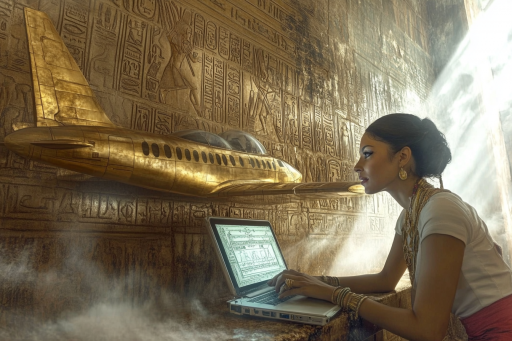
Throughout history, artists have captured the world around them in stone, paint, and metal. But what if some ancient artworks depict more than the technology of their time? Scattered across the globe, carvings, paintings, and statues appear to show objects that shouldn’t have existed—devices that look suspiciously like modern technology. Are these startling cases proof of lost civilizations, time travel, or something else entirely?
The Helicopters of Abydos

Deep in the Temple of Seti I in Egypt, an intricate carving appears to show a helicopter, a submarine, and other futuristic craft. While some claim the images are the result of overlapping hieroglyphs, others see them as evidence that ancient Egyptians had knowledge far beyond their time. Could these detailed depictions suggest forgotten technology, or do they hint at something even more mysterious?
The Astronaut of Salamanca

Carved into the façade of the New Cathedral of Salamanca in Spain is the unmistakable image of an astronaut—helmet, suit, and all. The cathedral dates back to the 16th century, yet the carving wasn’t added until a 1992 restoration. While skeptics dismiss it as modern artistic flair, its presence fuels debate about whether past civilizations glimpsed future technology—or if history is full of hidden time loops.
The Quimbaya Artifacts

Golden figurines crafted by the ancient Quimbaya civilization of Colombia bear an uncanny resemblance to modern airplanes. With swept-back wings, stabilizing tails, and aerodynamic shapes, they look less like birds and more like flying machines. Engineers have even created scaled replicas that demonstrate surprising flight capabilities. Were these merely artistic interpretations of nature, or something more advanced?
The “Laptop” of the Ancient Greeks

An ancient Greek relief, dating to around 100 BCE, appears to show a woman holding an open laptop-like device. Two small holes on its side resemble modern USB ports, and the scene itself suggests an otherworldly exchange of knowledge. While historians argue it’s simply a jewelry box or writing tablet, the eerie similarity to today’s screens is hard to ignore.
The Maya Astronaut of Palenque

The sarcophagus lid of Mayan ruler Pakal the Great is one of the most famous artifacts in ancient history. To some, it shows the king in a spaceship—his hands on controls, his body positioned as if launching into space. Mainstream scholars say it represents the journey to the underworld, but to others, it’s proof of an ancient connection to advanced extraterrestrial visitors.
The Indian Vimanas

Ancient Hindu texts describe flying machines called vimanas, said to be piloted by the gods. Detailed accounts speak of metallic crafts powered by mysterious energies, engaging in aerial battles and interstellar travel. Some researchers believe these stories could be based on real technology lost to time. Were these just myths, or did ancient civilizations witness something truly extraordinary?
The Baghdad Battery’s Electric Secret

A set of clay jars discovered in Iraq in the 1930s contained copper tubes and iron rods—leading some to believe they were primitive batteries. If functional, they could have generated small electrical charges, raising questions about their purpose. Did ancient civilizations harness electricity long before we believed possible?
The Prehistoric Cave ‘Lightbulb’

In the Hathor Temple of Dendera, Egypt, an unusual carving seems to depict a giant lightbulb, complete with a filament-like shape inside. Some theorists argue this represents ancient electrical knowledge, possibly powered by the Baghdad Battery. While skeptics say it’s a symbolic religious image, the resemblance to modern lighting is uncanny.
The Medieval UFO Tapestries

Several 15th and 16th-century European tapestries feature strange, flying objects in the sky. These disk-like shapes, sometimes emitting beams of light, bear a striking resemblance to modern UFO descriptions. Could they be artistic depictions of celestial symbols, or were medieval societies recording encounters with something unexplainable?
The Nazca Lines as Ancient Runways

The vast, mysterious Nazca Lines in Peru stretch across the desert in geometric precision. Some of these massive carvings resemble modern runways, while others depict strange humanoid figures seen best from the sky. With no clear reason for their construction, speculation continues—were they simply ritual sites, or could they have served an entirely different, more technological purpose?
The Moai’s Hidden Secrets

The giant stone heads of Easter Island, known as Moai, are famous worldwide—but fewer people know that their bodies are buried beneath the earth, etched with intricate carvings. Some believe these markings resemble ancient circuitry or coded messages. Were these figures once connected to something technologically advanced, or do they hide a lost chapter of human history?
Lost Knowledge or Time’s Greatest Trick?

Ancient artists created masterpieces meant to capture their world, yet some seem to have captured glimpses of ours. Are these images proof that knowledge has been lost and rediscovered countless times, or do they suggest something even stranger? Whether the result of forgotten civilizations, outside influences, or a trick of perception, these artifacts challenge the boundaries of what we think we know. Could history itself be repeating in ways we never imagined?





